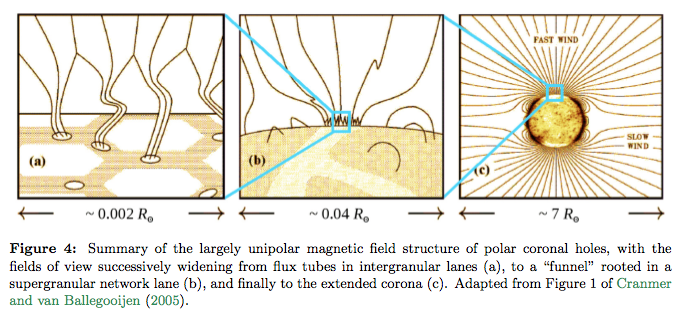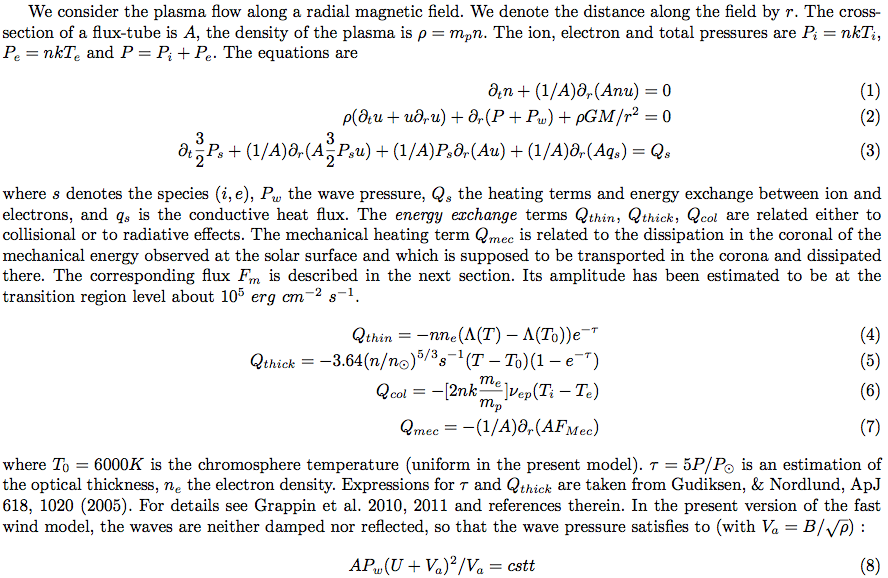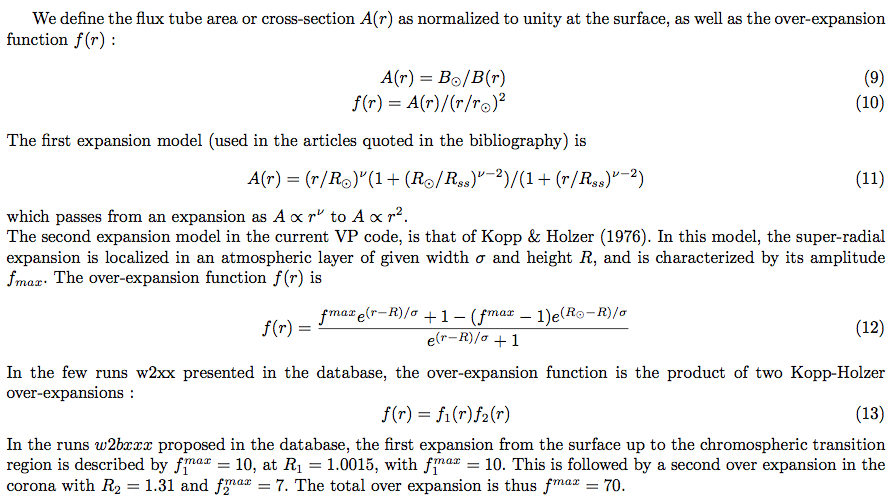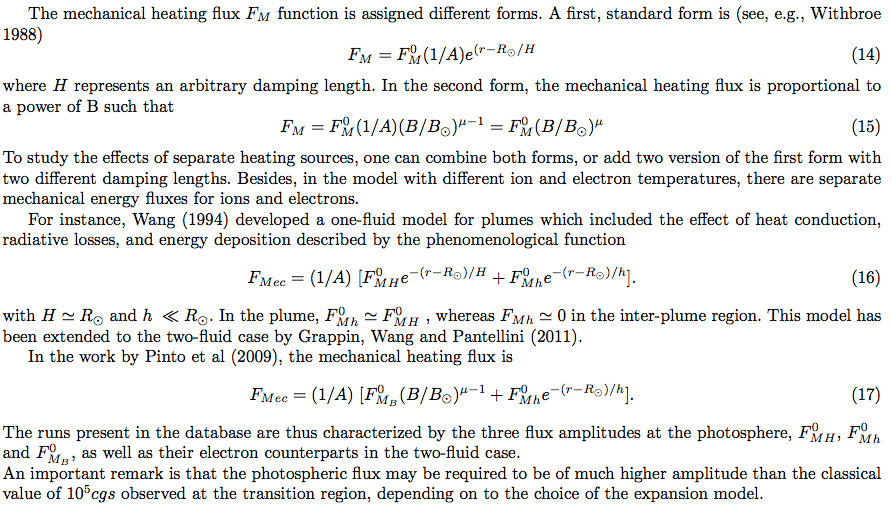DataBase of 1D Solar Wind model calculations by VP code - Documentation
Link to the VP DataBase
- VP Service Overview
- Astrophysical background and theoretical model
- Identification of Available Data
- Project members - Acknowledgements
- Contact and Citation Information
VP (Velocity Pressure code) provides access to numerical results obtained via a 1D Solar Wind hydrodynamical
code named VP (see ref. Pinto et al 2009 below) which computes the density, bulk speed, ion and electron temperatures
and pressures, as well as the wave pressure.
In the following, a calculation is called a ``run''. Each run corresponds in general to
a different choice of the control parameters, but also possibly on the specific form of the terms of the equations.
The numerical domain extends from the photosphere at T=6000K up to 30 solar radii for fast calculations, but
can be extended to larger distances.
The main control parameters are the mechanical energy flux and the magnetic field expansion rate.
The main variation of the equations deal with whether the wave pressure is taken into account or not, or whether
the ion and electron temperatures are equal or not.
Plot data. This option enables graphical display of the chosen run(s).
The List of fields allows the user to choose the plotted fields.
There are four panels in the graphical display. Each panel shows one of the four fields.
Up to four runs can be plotted simultaneously in each panel.
Retrieve data. This option enables to retrieve the data that would be displayed if
one would use the ''Plot data'' option, in the same order as the data would be plotted.
To each virtual ''curve'' corresponds
-
- a two-lines header made of the field name plus the unit used and the name of the run
-
- a two-column series: distances and field values
The end of each curve is marked by the string FINREC.
Display parameters. This option enables the user to browse the input parameters of a model to be chosen
from the corresponding list. Note that a short list of the main parameters appears
after the name of each run in the List of runs
Run on demand. Please contact
Roland Grappin
or
Filippo Pantellini
and ask for one or several runs with
specific values of the parameters.
If no special difficulty is encountered,
if no modifications of the code is required, and if the version of the code to be run is
considered "public" (see below present-day definition),
this service
is offered freely, as being one of the missions of R.G. and F.P. as Astronomers.
In the opposite case, special agreement must be taken, and the work is considered to be
scientific collaboration as usual.
Definition of "public version of the code"
At present (June 2012), the code for SLOW WIND, that is, without wave pressure,
is considered a public version.
This is the version used in the papers appearing at the bibliography at the end of this page.
For more information on the project see the
french document.
The wind model: equations and application


This model has been used in different versions (T_i = T_e or not, fully ionized or not).
Up to now, it has been used in published work as a slow wind model,
without wave pressure (see bibliography).
In these works, the viewpoint was that both high- and low-speed winds come from coronal holes (defined as open field regions), and that it is the rate of flux-tube expansion (see ref. in Pinto et al 2009) that controls the wind speed at 1 AU.
Thus, the slow wind tends to be highly variable because it emanates from just inside the boundaries of large coronal holes and from the small, rapidly evolving holes that form near active regions at sunspot maximum. Both of these sources are characterized by rapidly diverging fields.
The reader is invited to read the papers quoted in the bibliography below to have a
precise view of the equations of the different models.
We give here only a detailed account of two basic ingredients, namely the different forms of
-
the magnetic field expansion
-
the mechanical energy flux
The magnetic field expansion

The mechanical energy flux
 Up to now, all runs shown start from an initially cold (6000 K) hydrostatic atmosphere
which is perturbed by a pressure drop at the external shell (30 R_s)
and at the same time heated by an external mechanical energy flux.
Up to now, all runs shown start from an initially cold (6000 K) hydrostatic atmosphere
which is perturbed by a pressure drop at the external shell (30 R_s)
and at the same time heated by an external mechanical energy flux.
Only the last state of the wind is shown, with no garantee that it is really stationary.
A look at the number flux density × A(r) (nUA) offers a diagnostic of the stationarity of the plasma, since the curve should be flat at equilibrium.
Note that this may reveal ringing at some places where the mesh is insufficiently refined.
We checked that finer grids with no ringing lead to quasi-identical results for the primitive fields.
There at present three series of runs proposed to the user.
-
The first series ryXXX shows the runs studied in Pinto et al 2009, based on a one-fluid model.
It has allowed to study the formation of inflow and outflow and study the formation and decay
of plumes.
-
The second series newXXX shows the runs studied in Grappin et al 2011, based on a two-fluid model
(different ion and electron temperatures). It has allowed to generalize the previous plume model.
-
The third short series wbXXX shows four exploratory runs based on a third model, which
includes a strong expansion (the first two runs describe transient flows between the
initial hydrostatic phase and transonic wind)
and includes Alfvén waves, allowing to model fast winds (last run w2b1).
Bibliography of published works using the VP code.
-
Grappin, R.; Léorat, J.; Wang, Y.-M. Time-dependent simulations
of solar wind including the transition region SF2A-2006:
Proceedings of the Annual meeting of the French Society of Astronomy and
Astrophysics Eds.: D. Barret, F. Casoli, G. Lagache, A. Lecavelier, L. Pagani, p.543 (2006)
-
Pinto R., Grappin R., Wang Y.-M., Léorat J. Time-dependent hydro-
dynamical simulations of slow solar wind, coronal inflows, and polar
plumes. Astronomy and Astrophysics vol. 497 (2) pp. 537-543 (2009).
-
Wang Y.-M., Ko Y.-K., Grappin R. Slow Solar Wind from Open Regions with Strong
Low-Coronal Heating. The Astrophysical Journal vol. 691 pp. 760 (2009)
-
Grappin, R., Léorat, J., Leygnac, S. and Pinto, R. Search for a self-consistent
solar wind model. TWELFTH INTERNATIONAL SOLAR WIND CONFERENCE. AIP Conference Proceedings 1216, 24-27 (2010).
-
Grappin R, Wang Y-M and Pantellini F TWO-TEMPERATURE MODELS FOR POLAR PLUMES :
COOLING BY MEANS OF STRONG BASE HEATING Astrophysical Journal 727 1-5 (2011)
-
Wang, Y.-M., Grappin, R., Robbrecht, E. and Sheeley, N. R., Jr ON
THE NATURE OF THE SOLAR WIND FROM CORONAL PSEUDO-STREAMERS. The Astrophysical Journal 749, 182 (2012).
Input of the database will evolve due to discussions between the core members who started the
project, namely:
G. Aulanier (LESIA),
R. Grappin (LUTH and LPP),
F. Pantellini (LESIA), and
Y.-M. Wang (NRL).
Input from the community, such as suggestions to explore different parameter ranges,
as well as to consider different physical effects, are welcome.
The code has been developed due to the efforts of the following people:
- polytropic code with compact finite differences and transparent boundaries (E.Cavillier + R.Grappin 1995-96)
- modified compact scheme allowing non uniform mesh (J-M LeSaout 2003)
- heat sources and sinks (R.Grappin, J.Leorat, Y-M.Wang 2006-2008)
- additional work on non uniform mesh (R.Grappin + Rui Pinto 2008)
- partial ionization effects (R.Grappin+S.Leygnac 2008)
- ion and electron temperatures coupling (F.Pantellini + R.Grappin 2008-2009)
- wave pressure (R. Grappin 2012)
The following people have indirectly or directly contributed to the VP project:
-
Dr. Natalia Papitashvili (NASA) whose
COHOWeb
site providing
observational solar wind data has been inspiring for us
-
W.M. Davis (Princeton Plasma Physics Lab) who kindly provided a first version of the perl code
allowing to communicate between html and IDL language
-
Shadia Habbal for extensive reading and suggesting several improvements to this text
For questions or comments about the VP service or data,
please contact Dr. Roland Grappin
(Roland.Grappin@obspm.fr),
or Dr. Filippo Pantellini
(Filippo.Pantellini@obspm.fr),
Observatoire de Meudon, F-92195 Meudon.
Curator:
Roland Grappin
Updated: August 29 2017 12:27



